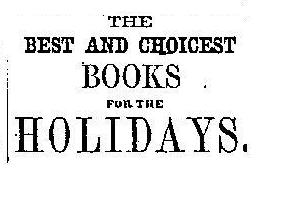Civil War era newspapers were more than just sources of information regarding current events. In the Boston Daily Advertiser, for example, nearly half of any given issue was devoted to advertising. It was certainly not alone in this, though it was at least honest enough to include the word “advertiser” in its name. Goods and services of many varieties, many of which sound somewhat strange today, can be found in the seemingly endless columns of ads.![]()
According to items printed in the Daily Advertiser on November 9, 1864, Boston was well supplied for the celebrations which Lincoln supporters must have participated in on the day after his re-election. Perhaps no post-election party would be complete without plenty of Holland Gin, with exotic varieties like palm tree, double pineapple and imperial crown. Or, for those looking for somewhat less conventional refreshment, prime Turkish opium was available for sale by Nicholas Reggio & Co. at 31 Central Warf, though to be fair in 1864 this was more likely intended for medicinal uses. Fortunately for the opponents of the President, there were also many miracle remedies for sale throughout the city which could cure any illness caused by their disappointment. People who were tempted to buy some of that Holland Gin for purposes other than celebration, for example, could turn instead to the new miracle product Speranza, “An Italian preparation to destroy the appetite for intoxicating liquors.” Or, voters who felt positively faint at the prospect of another four years of Lincoln could purchase The Peruvian Syrup, which contained the “vital principle or life element, iron” and could cure “a low state of the system.” These are just a few examples of the myriad of remedies that promised to lead consumers to perfect health, most of which seem dubious to people, like us, used to a professional and regulated medical industry. It is possible that these products really were as great as they sound, but one suspects that the purveyors of these miracle medicines were fortunate that the FDA was still half a century in the future.
There is more that can be learned from reading advertisements, however, than what items were for sale. Unlike today, when business owners with instant communication and information technology can fine tune to an exact science what and how much they should have on their shelves at any given time, mid nineteenth century business required a little more guesswork. Therefore, we can see announcements for 8,500 goat skins, 100,000 dry pine boards and 6,000 pounds of whale oil soap. These numbers suggest that many merchants would buy in bulk from whatever cargo a ship brought into port, and then hope to sell it off over time. Also, such large amounts probably mean that unlike modern advertisements targeted to individual consumers, these types of ads were directed at other business owners who would buy in such large quantities to stock their stores. This was one of the ways businesses communicated with each other before modern technology.
 Finally, there is a certain segment of the population who, every December, decries the fact that many people now opt to use the word holiday rather than Christmas. Some go so far as to proclaim that a vaguely defined but still suspicious cabal has declared war on Christmas itself. They insist that this is a recent phenomenon which is somehow symbolic of America’s moral decay. What they most likely do not
Finally, there is a certain segment of the population who, every December, decries the fact that many people now opt to use the word holiday rather than Christmas. Some go so far as to proclaim that a vaguely defined but still suspicious cabal has declared war on Christmas itself. They insist that this is a recent phenomenon which is somehow symbolic of America’s moral decay. What they most likely do not  know, however, is that in the December 24, 1864 issue of the Boston Daily Advertiser, despite the fact that on that date it was full of ads for gifts intended for the December festivities, the word Christmas can be found only 3 times, always in small print. The word “holiday,” in contrast, is printed numerous times, often in large type, directing readers’ attention to “Books for the Holidays” or “A Superb Holiday Gift.” Perhaps those preparing to do battle in defense of Christmas should reflect on the fact that despite the word’s almost total absence in 1864, the United States has somehow managed to survive.
know, however, is that in the December 24, 1864 issue of the Boston Daily Advertiser, despite the fact that on that date it was full of ads for gifts intended for the December festivities, the word Christmas can be found only 3 times, always in small print. The word “holiday,” in contrast, is printed numerous times, often in large type, directing readers’ attention to “Books for the Holidays” or “A Superb Holiday Gift.” Perhaps those preparing to do battle in defense of Christmas should reflect on the fact that despite the word’s almost total absence in 1864, the United States has somehow managed to survive.
Hopefully at least some of these facts proved interesting, but maybe the most important thing to learn from reading advertisements in Civil War era newspapers is that, unfortunately for those longing for a simpler time, even if you go back 150 years, someone will still always be trying to sell you something.

I was enjoying this article about the Civil War until I got sucker-punched for my desire to honor Christ’s birthday by calling it Christmas. It was unnecessary to verbalize such animosity toward those of the Christian community for their passion to preserve the holiness of this day.
Apologies to anyone who took offense. The intention of the blogger was not to take sides in a religious debate, but rather to point out connections between the past and the present in the historical and cultural celebration of holidays like Christmas.
For those interested in learning more about the history of celebrating Christmas in America, Stephen Nissenbaum’s book “The Battle for Christmas” is a great place to start. Nissenbaum explains the origins of traditions like Santa Claus and Christmas trees, and his research demonstrates that concerns about commercialism and the lack of religious emphasis during the Christmas season are not new to us today.